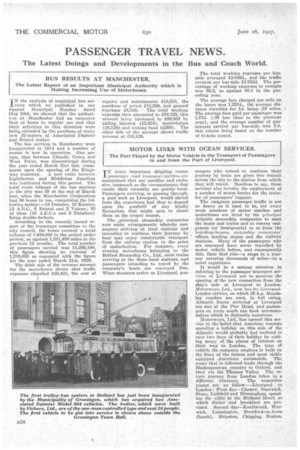MOTOR LINKS WITH OCEAN SERVICES.
Page 56

Page 57

If you've noticed an error in this article please click here to report it so we can fix it.
The Part Played by the Motor Vehicle In the Transport of Passengers to and from the Port of Liverpool.
IN every important shipping centre passenger road transport services are maintained that are peculiar and.exclusive, inasmuch as the circumstances (hat create their necessity are purely local. PaSsongers arriving, or passing through, a port such as Liverpool, would shrink from the experience had they to depend upon the goodwill ofany kindly Samaritan that might care to direct them on the proper course.
The dprincipal steamship companies now make arrangements whereby passengers arriving at local stations and intending to continue their journey by boat may enjoy comfortable transport from the railway station to the point of embarkation. For instance, every evening motorbuses belonging to the Belfast Steamship Co., Ltd., meet trains arriving at the three lacal stations, and passengers intending to travel by the Company's beats . are conveyed free. When steamers arrive at Liverpool, pas sengera who intend to continue their journey by train are given free transit across the city to the station from which they will travel. Needless to say, these services also involve the employment of a number of motor lorries for the transferof passengers' luggage.
The emigrant passenger traffic is not so heavy as it used to be, yet every week numbers of motor coaches and motorbuses are hired by the principal Atlantic steamship companies to meet the boats and trains and to convey einigrants (or immigrants) to or from the boarding-houses, steamship companies' offices, landing stages and the railway stations. Many of the passengers who are Conveyed have never travelled by motor vehicle before, and consequently. this, their first ride—a stage in a journey covering thousands of miles—is a novel experience.
It would be a serious omission in referring to the passenger transport services of Liverpool not to mention the opening of the new connection from the ship's side at Liverpool to London. Motorways, Ltd., now has its LiverpoolLondon service, on which 35 b-p. Mauclslay coaches are used, in full swing. Atlantic liners arrivind at Liverpool are met at the Pier Head, and passengers en route south can book accommodation which is distinctly luxurious.
Motorways, Ltd., has opened this service in the belief that American tourists spending a holiday on this side of the Atlantic would probably feel inclined to save two days of their holiday by visiting many of the places of interest on their way to London. The type of vehicle the company employs is built on the lines of the fastest and most richly equipped American automobile. The route that is followed leads through the Shakespearean country to Oxford; and then via the Thames Valley. The return journey from London takes in a different itinerary. The respective routes are as follow :—Liverpool to London : First day—Chester, Nantwieh. Sione, Lichfield and Birmingham, spending the night at the Midland Hotel, at which dinner and breakfast are provided. Second day—Kenilworth, Warwick, Leamington, Stratford-on-Avon (lunch), Shipston, Chipping Norton, Woodstock, Oxford, Maidenhead and London.
Loudon to Liverpool: First day— London, Beaconsfield, Aylesbury, Buckingham, Winslow (lunch), Sulgrave, Banbury awl Stratford-on-Avon, at which the night is spent, and dinner and breakfast served. Second day : Worcester, Kidderminster, Bridge Norton, Muds Wenlock, Shrewsbury (lunch), Whitchureh, Chester and Liverpool.
The two journeys are thus both varied and complementary. The single fare in either direction is 20 dollars, or £4 2s, ed., and the return fare 39 dollars or £8, which includes the motor tour, first-class hotel accommodation, meals and free carriage of certain baggage.
As to the coach itself, its equipment is both novel and luxurious. Its main features consist of an American soda fountain, automatic machines for cigars and two varieties of cigarettes, pneumatic seats, central-heating apparatus, an electric heater for food, a freshwater supply and a lavatory.




































































































